

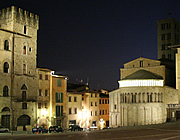
Wonderful frescoes by Piero della Francesco and lovely Tuscan towns and villages.
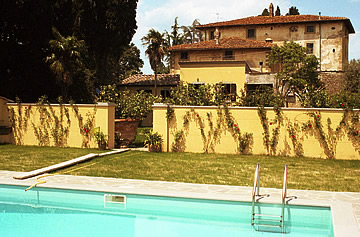
In 1991 we had a blissful two weeks at a lovely villa just outside Arezzo, spending the time exploring Florence, Pisa, Siena, and many of the hill towns and villages in the region.
The villa was absolutely pristine, everything new, with its own pool and a garden filled with lemon trees in huge pots. Admittedly the pool was only filled a couple of days after we arrived, causing our water pressure to drop, but it was lovely to have it. We also had problems with the gas supply (the tank was empty), and the electricity going off, but hey, this is Italy, they got sorted soon enough and we had plenty of food and drink and lovely surroundings.
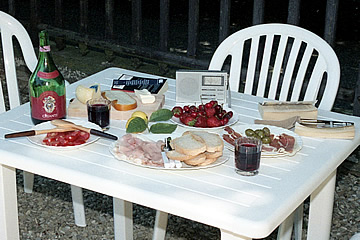
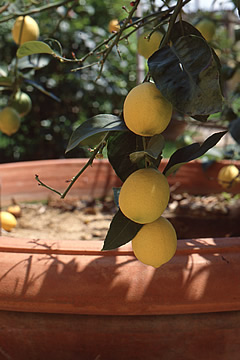
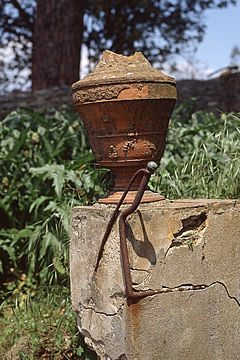
The day we arrived the caretaker's family was gathering as his father had just died, a rather surreal experience, especially as the funeral was held a couple of days later.
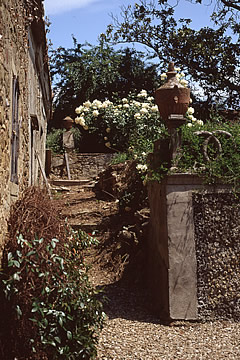
We spent two or three days, in between sightseeing days, just relaxing in Arezzo and at the villa, with some very enjoyable al fresco dining.
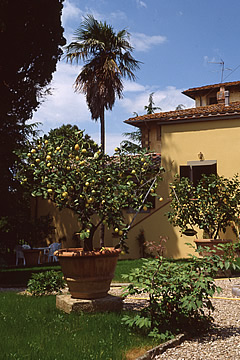
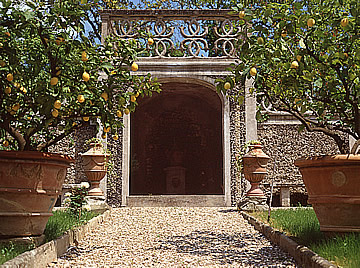
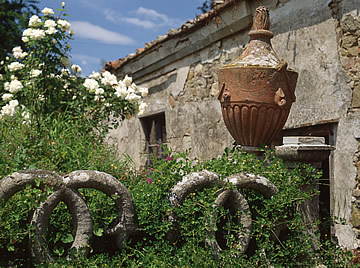
In 2007 we returned to Arezzo, mainly for the "Piero della Francesca and the Italian Courts" exhibition. I was already very familiar with many of Piero's works in the region and this was a great chance to see them all again and visit some new ones.
Arezzo was an important settlement from Etruscan times, controlling access to the major passes of the central Apennines, right through to the Middle Ages, until it found itself on the wrong side and suffered a military defeat at the hands of the Guelph Florentines in 1289.
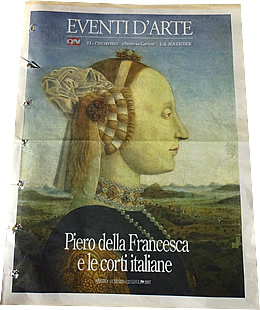
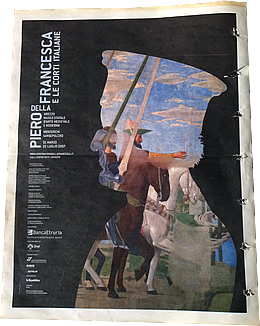
As well as the frescoes and paintings by Piero in the region, the exhibition had drawn together important works of art from around the world by Piero and contemporary artists, displayed in the local museum.
The publicity material used the profile of Federico da Montefeltro, Duke of Urbino, extensively - he was an accomplished military leader and patron of the arts. That and the profile of his wife Battista are from the celebrated dyptych by Piero della Francesca which normally resides in the Uffizi in Florence but had been loaned to Arezzo for the exhibition.
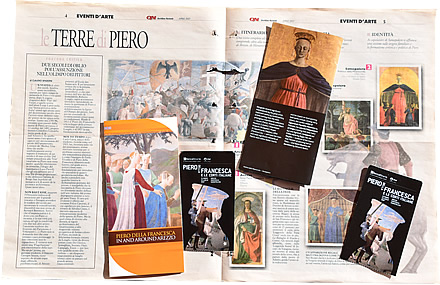
In Arezzo there are two places to see his work: in the Cappella Bacci of the Basilica di San Francesco there is a series of frescoes on the Legend of the True Cross, and in the Duomo a fresco of Santa Maria Maddalena.
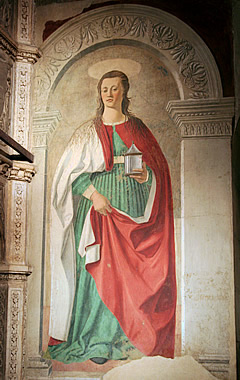
The thoughtful, serene look of Mary Magdalene, her gaze lowered beneath heavy lids, is unmistakable Piero, the shape and solidity of her body, the slipper-clad foot beneath the hem of her robe, are all very distinctive.
In 1991 the frescoes in San Francesco were covered in scaffolding, being restored, but in 2007 they were revealed in pristine glory. The wealthy Bacci family owned the chapel and had commissioned the Florentine painter Bicci di Lorenzo to decorate the walls and ceiling in 1447. He had completed the ceiling, two Doctors of the church on the entrance, and the Last Judgement on the triumphal arch, when he died in 1452.1 Piero della Francesca took over and created one of the masterpieces of the Renaissance. At the time this would have been a very modern artistic creation in the use of perspective and the appearance of the figures, mostly calm and contemplative, even in the midst of battle. Piero was an early master of perspective painting and this is employed to great effect throughout the cycle of frescoes.
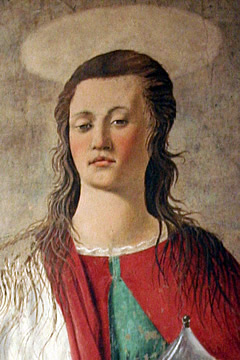
The frescoes occupy three levels and are arranged by subject matter rather than chronologically telling the story of the cross, its creation, loss and discovery by the Empress Helena, mother of the great Emperor Constantine. Within the frescoes Piero painted depictions of local landscapes and towns, including Arezzo and Sansepolcro.
We spent almost two hours in the exhibition which was so much more than expected. It had two of Piero's early works, a St Jerome and a Madonna and Child, plus several others including Sigismundo Malatesta which is now in the Louvre. Plus the wonderful diptych of Federico da Montefeltro and his wife Battista with the lovely trionfi on the reverse, from Florence, and a wonderful Madonna and Child with Angels from Urbino which I couldn't remember seeing from our visit there.
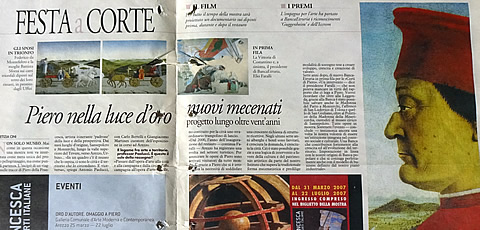
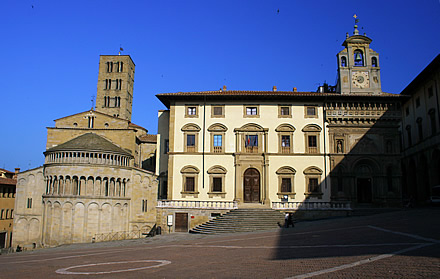
On top of all this there were masterpieces by contemporary artists, some who were influenced by his work such as Luca Signorelli (born not far away in Cortona) and Giovanni Bellini, others who influenced Piero, such as Pisanello (his 1445 medal of Sigismundo Malatesta for instance) and Roger Van der Weyden. To recover we had a glass of prosecco in the gallery garden in the shade.
Arezzo is a pleasant town with a fine Piazza Grande. On its north side is Vasari's elegant Renaissance loggia. Vasari was born in Arezzo in 1511 and became skilled as artist, architect and writer.
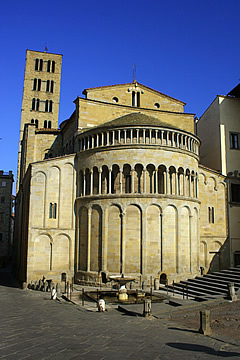
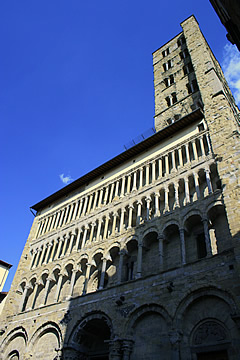
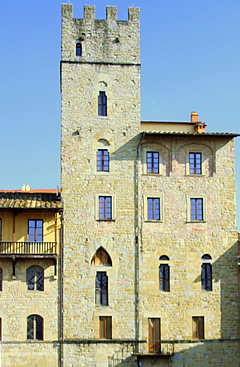
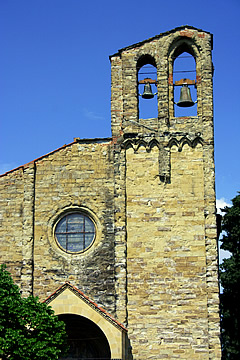
The church of Santa Maria della Pieve stands on the west side of Piazza Grande, though with its back to the piazza. The current church was created mostly during the twelfth and thirteenth centuries and its most striking feature is the west front with five Romanesque arches on the ground floor surmounted by three loggias with progressively increasing numbers of columns. The fourteenth century campanile is known locally as the "Tower of a hundred holes" because of its large number of windows.
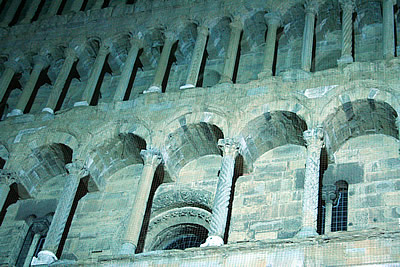
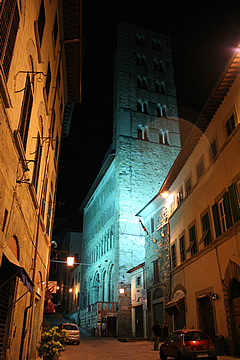
The town has many churches including 14th century San Domenico which has a wonderful crucifix by Cimabue.
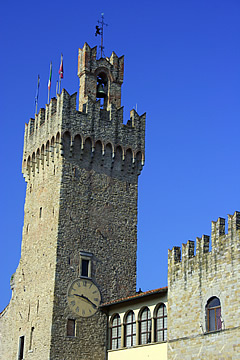
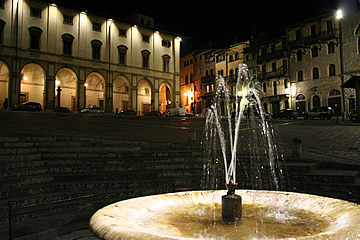
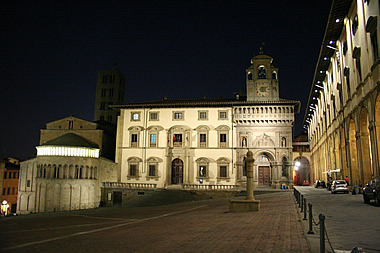
There are some good places to eat. We had an excellent lunch at Osteria l'Agania - ham and pecorino for Andrew then pasta pomodoro, for me a good caprese salad, and two excellent meals at Il Cantuccio - tagliatelle cinghialle (wild boar) and cantucci/vin santo were particularly good.
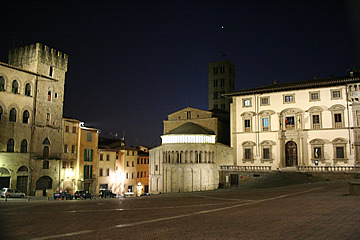
And we had a celebration anniversary meal at Lancia D'oro in Vasari's loggia on Piazza Grande, where we ate far too much. Memorable lasagnette with truffle shavings and papardelle lepre (hare), lamb and cinghiale. The waiter gave me the gorgeous napkin tie - a white and gold ceramic crescent moon, which hangs on our Christmas tree
.
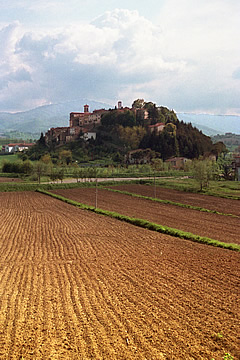
A tiny hilltop village with one of my favourite Piero della Francesca's. The Madonna del Parto was painted by Piero in the ancient country church of Santa Maria a Mementana just outside Monterchi. It was particularly apt for him as his mother was born in Monterchi. This is the only representation of the pregnant Madonna in Renaissance art and is highly revered.
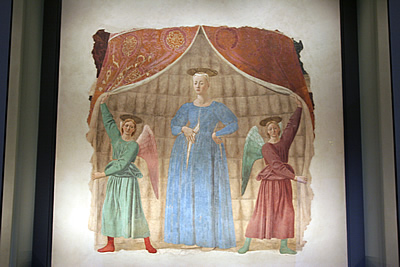
The fresco was probably painted some time between 1450 and 1465. In 1785 it was decided to build a cemetery where the church stood and the church was part demolished to create a new cemetery chapel.2 Two earthquakes in 1789 and 1917 badly damaged the chapel but the fresco survived. In the early 1990s the fresco was detached from the chapel wall so that it could be restored. It was never returned to the chapel.
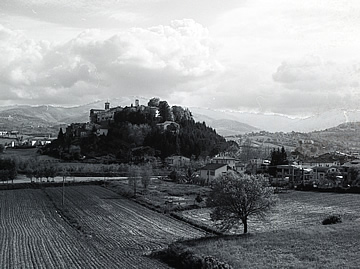
Originally it was necessary to go to the chapel, which is outside the town, and find the custodian to get him to open it up; even then you could only peer through a barred gate to see it, though it's a very small chapel and the fresco could be seen quite well. This was how we viewed the painting in 1991. When we returned in 2007 we found it had been moved to a museum in Monterchi. It's not quite as atmospheric viewed here, but still as beautiful. I suppose it was just too precious to leave in the chapel.
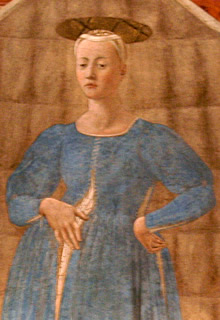
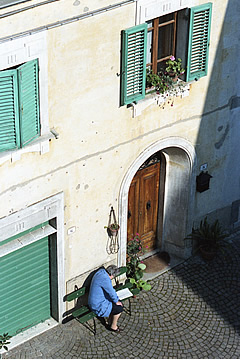
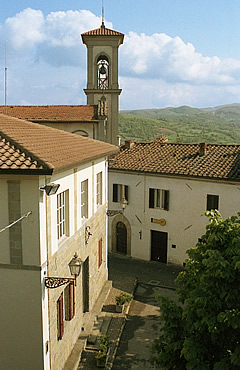
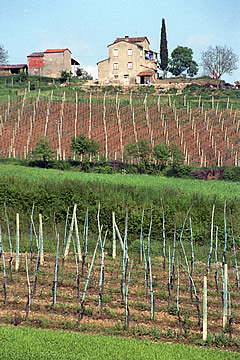
The fresco is very beautiful. The pregnant Madonna is literally presented to the viewer in an ornate tent whose drapes have been drawn back by two angels - two very down-to-earth angels, typically Piero. The colours of their clothing are complementary green and red - wings, gown and stockings.
Again the look of the Madonna is classic Piero, a serene and lowered gaze, sad as though she is already aware what will happen to her son.
The fresco had been beautifully restored.
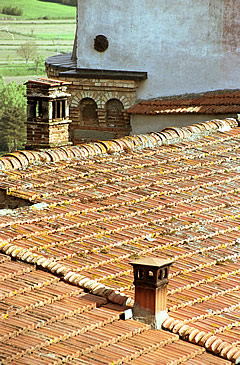
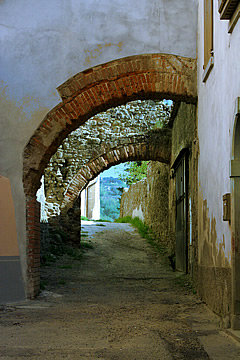
In both 1991 and 2007 we wandered around Monterchi. There isn't really anywhere to eat or get a drink - many years ago there was some kind of bar/store where you could also get something very basic to eat, a pasta in a tomato sauce maybe, cooked in the kitchen of the home, with some local red wine and crusty bread. Very good too, but the old ways are gradually disappearing, maybe long gone.
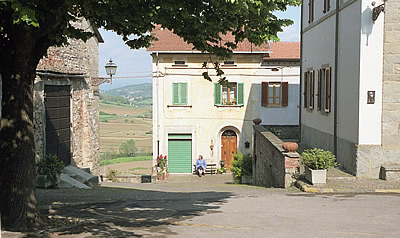
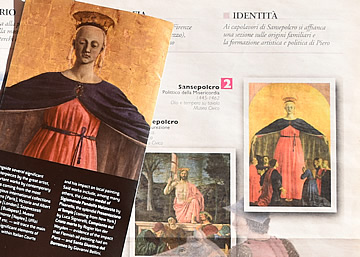
Sansepolcro is Piero's birthplace and it has two wonderful works by him and a couple of beautiful fragments.
The Polyptych of the Misericordia is another beautiful work of art. The Madonna of Mercy, or Misericordia, shelters the commissioners of the artwork, the Sansepolcro Compagnia, and the faithful, beneath her outspread cloak - men on her right, women on her left.
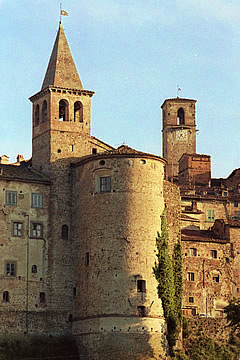
This is a monumental work of art that took Piero seventeen years to complete - he was known to take a long time over his work. Apart from the central Madonna there are beautiful portrayals of disciples, saints and angels, and smaller panels of scenes from the life of Christ such as the flagellation and crucifixion. This Madonna is a classic Piero depiction of the holy female - she has the most benevolent, serene appearance, unsmiling thoughtful face, downcast gaze.
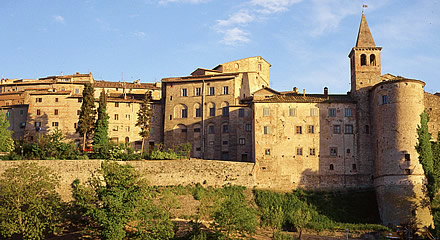
The Resurrection painting is one of my favourites.
This fresco was painted by Piero for the council chamber in Sansepolcro. Four soldiers sleep at the base of Christ's tomb, which Piero has depicted as a classical sarcophagus, while Christ is born again. His is again a serene gaze, a benevolence radiates from the figure, as befits one who has died to save humanity.
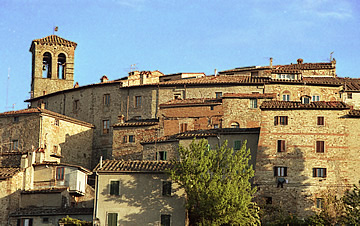
The trees in the background of the painting are young and fresh on Christ's left, old and bare, perhaps dead, on his right - these are again symbolic of rebirth.
Balance is paramount in this painting, to the point where one of the soldiers has no legs! It is suggested that to paint them in would have spoiled the painting's symmetry. The soldier in the brown armour is thought to be a self-portrait.
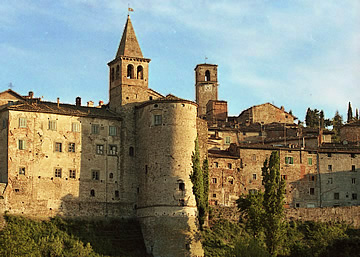
We dropped into Anghiari, which is just west of Sansepolcro, on the way back from Urbino to pick up supplies when we were staying in the villa in Arezzo in 1991. It is another lovely hilltop town and with an impressive wall surrounding it.